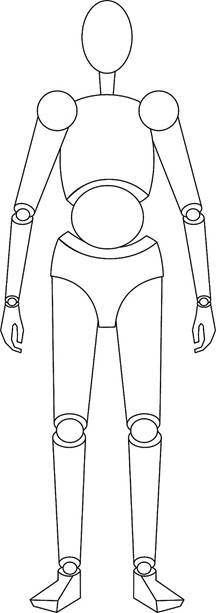
Concept explainers
If you had to design a model of the human body composed entirely of regular geometric solids, which solid shapes would you choose? Using a straightedge, sketch a model of the human body that incorporates the solid shapes you have selected.
To explain: The model of human body with different solid shapes.
Concept introduction: In general, human body is made of segments in irregular shapes and diverse mass distributions. Human body is made of bone, muscles, and fat that have different densities and distributed unevenly in individuals.
Explanation of Solution
Some investigators modeled the human body using different geometric solids. This helps an individuals to calculate the moment of inertia for regularly shaped solid substances. Fig.1 represent the model of human body that incorporates the solid shapes using s straightedge.

Fig.1: Model of human body using different solid shapes.
The solid shapes that are used to construct the model of human body are given below:
- Head is elliptical in shape.
- The neck region is slender cylindrical in shape.
- Scapula and clavicle are joined together in circle shaped articulating bones.
- Trunk part of the human body is cylinder in shape.
- The abdomen region is spherical in shape.
- Humerus, ulna, radius, femur, tibia, and fibula bones on the hands and legs are cylindrical in shape.
- The pelvic region of the human model is in cone shape.
- Elbows, tendons, and joints are spherical in shape.
- Feet resemble pentahedron shape.
Want to see more full solutions like this?
Chapter 14 Solutions
Gen Combo Ll Basic Biomechanics; Connect Ac; Maxtraq Software Ac
- Match each of the following terms with the correct meaning. ________ Caudal a. Lying on the back, face upwards b. Farther from the point of attachment c. The front of the body or body part d. Toward the tail end of the spinearrow_forwardMatch each of the following terms with the correct meaning. ________ Ventral Lying on the back, face upwards Farther from the point of attachment The front of the body or body part Toward the tail end of the spinearrow_forward
 Medical Terminology for Health Professions, Spira...Health & NutritionISBN:9781305634350Author:Ann Ehrlich, Carol L. Schroeder, Laura Ehrlich, Katrina A. SchroederPublisher:Cengage Learning
Medical Terminology for Health Professions, Spira...Health & NutritionISBN:9781305634350Author:Ann Ehrlich, Carol L. Schroeder, Laura Ehrlich, Katrina A. SchroederPublisher:Cengage Learning Principles Of Radiographic Imaging: An Art And A ...Health & NutritionISBN:9781337711067Author:Richard R. Carlton, Arlene M. Adler, Vesna BalacPublisher:Cengage Learning
Principles Of Radiographic Imaging: An Art And A ...Health & NutritionISBN:9781337711067Author:Richard R. Carlton, Arlene M. Adler, Vesna BalacPublisher:Cengage Learning- Case Studies In Health Information ManagementBiologyISBN:9781337676908Author:SCHNERINGPublisher:Cengage
 Fundamentals of Sectional Anatomy: An Imaging App...BiologyISBN:9781133960867Author:Denise L. LazoPublisher:Cengage Learning
Fundamentals of Sectional Anatomy: An Imaging App...BiologyISBN:9781133960867Author:Denise L. LazoPublisher:Cengage Learning





